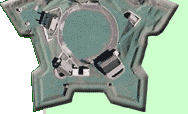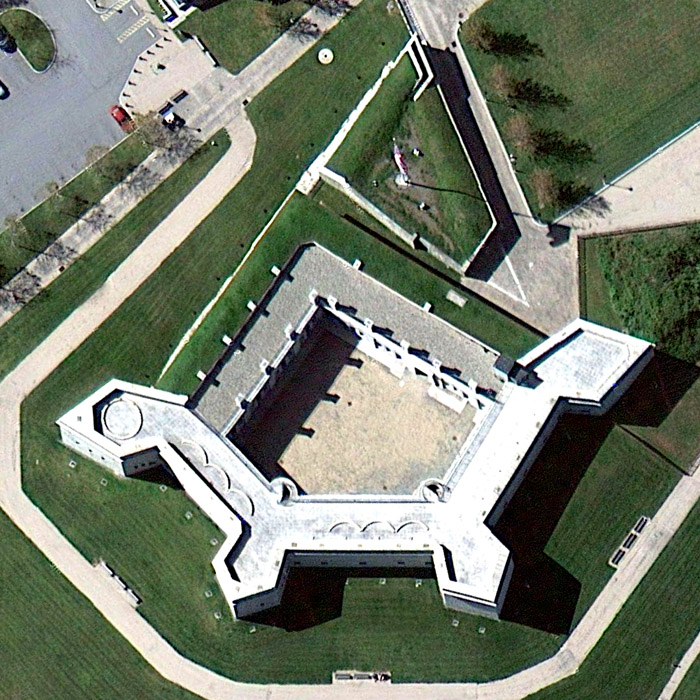
 |
 |
Fort Trumbull New London, Connecticut |
 |
 |
 |
 |
 |
||
 |
The area where New London, CT stands today was first settled by the Pequot indians, who called the spot Nameaug. John Winthrop the Younger (1606-1676), son of the founder of the Massachusetts Bay Colony, landed, kicked out the indians and established an English settlement there, calling it Pequot after its previous inhabitants. On March 10 1683 the Connecticut General Assembly officially named the town New London. New London sports an excellent harbor at the mouth of the Thames harbor on Long Island Sound, which naturally made it a likely place to need defending. Connecticut Governor Jonathan Trumbull (1710-1785) suggested New London might be a fine place for a star fort in 1775, and by 1777 the first iteration of Fort Trumbull was complete. Two years later, Benedict Arnold (1741-1801) had a problem. Though he had performed brilliantly as one of the most effective American commanders in the American Revolutionary War (1775-1783), many of his military accomplishments had been undone through the incompetence of his superiors, most of whom were political appointees of the ineffectually flapping Continental Congress in Philadelphia. Arnold was acquitted of politically inspired charges of corruption, but he'd had enough. When he was given command of the military facility at West Point, New York, he first passed information to the British about its strength, and then plotted to hand it over to them whole. The plot was exposed, and Arnold officially changed sides, being granted the rank of Brigadier General in the British Army. Why are we going on about Benedict Arnold? Because, y'see, on September 5, 1781 General Arnold led a force of 1700 men to New London, where they captured the American position at Fort Griswold, which sat on the opposite side of the Thames River from Fort Trumbull. Fort Griswold's commanding officer, a Colonel Ledyard, offered his sword to Arnold and asked for quarter for his men. A contemporary account has Arnold responding with a snarl of "Ye rascals, I give you quarters!" and plunging his sword into the surrendering American officer's breast. The remainder of the garrison were bayonetted by the wicked British. Did this actually happen? One wonders. Benedict Arnold's defection to the British made him a pretty darned unpopular figure in the US, then and now, but the guy had all sorts of nonsense made up about him even before he turned traitor. No less authoritative a voice than Jon Lincoln, the current park supervisor for Fort Trumbull and Fort Griswold State parks in Connecticut, reports that 'twas not Benedict Arnold who was responsible for the massacre of the defenseless defenders. Mr. Lincoln tells us that it was a British Major Bromfield, likely enraged by the death of his commanding officers at the hands of a bunch of colonial jerks who by all rights should have surrendered in a more proper fashion earlier (Lieutenant Colonel Eyre and Major Montgomery, commanding the two British regiments involved in the attack, were killed in the process), who plunged his sword into the chest of the actively surrendering Colonel Ledyard and allowed the following massacre to take place. But one might wish to visit our Fort Griswold page for the full story. Regardless, after whatever happened at Fort Griswold, Arnold and his band of merry redbacked men swept across the Thames and scooped up Fort Trumbull with little difficulty. Following the War of 1812 (1812-1814), US President James Madison (1751-1836) appointed a Board of Engineers for Fortifications to study various locations on the US' east coast, in the interest of improving the nation's seacoast defense. The forts built or improved on the suggestion of this Board came to be known as the Third System of US coastal defense. One of the Board's first 21 suggested sites for improvement was Fort Trumbull. The fort as it appears today was built from 1839 to 1852 under the direction of Army engineer George Washington Cullum (1809-1892), who would go on to serve as Superintendent of the US Military Academy at West Point: Good thing Benedict Arnold's dastardly scheme was foiled! During the US Civil War (1861-1865), Fort Trumbull was used as a training depot for Union soldiers. It was briefly commanded by John F. Reynolds (1820-1863), who would die at the Battle of Gettysburg, at the rank of major general, in July of 1863. In the 1880's, America's vaunted coastal defences were rendered obsolete by the advent of rifles, breech-loading artillery, fired with smokeless powder...advances made primarily in Europe. In May of 1885, US President Grover Cleveland (1837-1908) appointed a board headed by his Secretary of War, William Crowninshield Endicott (1826-1900), to study the issue and look into what changes might be necessary. The following year, the Endicott Board pronounced that modern artillery must be emplaced for the defense of the realm, but at the time US industry was unable to manufacture the necessary arms. Work in this direction proceeded grudgingly over the next decade, but sped up towards the end of the century with fears of some imaginary, unstoppable Spanish fleet bombarding the US coast. Happily, the Spanish-American War (1898) showed almost-post-colonial Spain to be a threat to virtually no one. By the early years of the 20th century, several Endicott-era fortifications had popped up in defense of Long Island Sound, with Fort Trumbull acting as their headquarters. In 1910 the fort was given to the Revenue Cutter Service (later christened the US Coast Guard), which used the fort as its service academy until 1932, when the Coast Guard Academy was moved to its current location in New London. During the Second World War (1936-1945) Fort Trumbull was used as the Merchant Marine Officer Training School, training most of the Merchant Marine officers who served during the war. The fort served as a satellite campus for the University of Connecticut from 1946 to 1950, educating veterans who were attending college under the GI Bill. Fort Trumbull was used by the US Navy from 1950 to 1990 as the Naval Underwater Sound Laboratory, where research and development of sonar took place. The fort was reconstructed for several years thereafter, and finally opened as a state park in 2000. I visited Fort Trumbull, sort of, in 2013. Won't you visit the Fort Trumbull page in our Starforts I've Visited section to see pix & read my observations? |
 |
 |
||
|
|
|||||||
 |